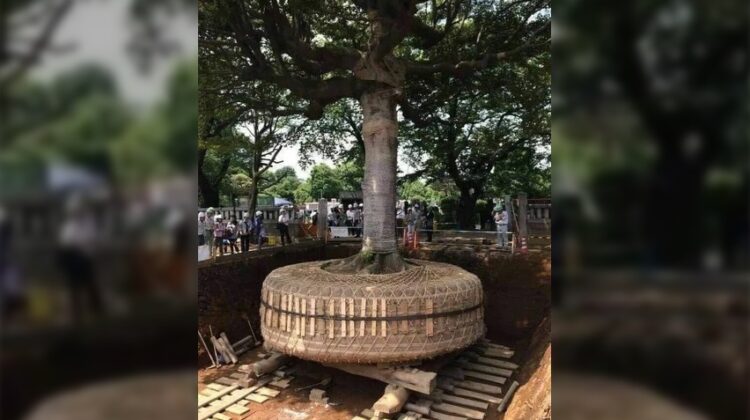
In the heart of Tokyo’s Minato Ward, where numerous embassies find their home and international residents of the city reside, an intriguing decision was made by the local authorities. Unbeknownst to many, the venerable camphor tree situated in the historic Arisugawa Park was destined to embark on a unique journey – a journey that would see this magnificent tree relocated.

By chance or perhaps by destiny, I happened to be present on the day of this monumental move. As I passed by, I was greeted by a sight that left me astonished – a sizable gathering of individuals adorned with helmets, congregated around the mammoth tree. This ancient giant had been stripped of its foliage, and its roots were meticulously encased in straw bunting.

The scene bore a resemblance to the intricate preparations of traditional festivals I had witnessed over the years. It evoked memories of the grand Mikoshi procession during Kyoto’s Gion festival and the Chichibu night festival, which unfolds just beyond Tokyo’s borders. In a similar fashion, the tree had been lifted, securely fastened, and positioned atop sturdy horizontal wooden beams equipped with rollers that rested upon wooden tracks, ready to guide its journey. In this elaborate operation, even specific names were assigned to the front rollers – “Kanzashi” – and the rear rollers – “Okagura.”
A tall, square mound of earth had been meticulously prepared to serve as the tree’s new abode. Diligent workers tirelessly cleared away any stray stones or debris that could potentially obstruct the tree’s forward movement.

What unfolded before my eyes was a manifestation of ancient engineering techniques, a tradition rarely called upon but still cherished by dedicated experts. The great move called for the assembly of approximately 10 to 15 skilled professionals, alongside around 60 gardeners, engineers, and technicians who played vital roles in ensuring the success of this monumental endeavor.
Later, I returned to witness the tree’s grand relocation. A sign had been posted to inform the neighborhood of the momentous occasion, scheduled for July 26 at 10 am. The colossal 70-ton tree was set to journey a mere 10 meters. By sheer coincidence, I had driven past the impressive assembly and the tree enveloped in straw, but now I walked back to the scene, arriving just in time to witness the culmination of this extraordinary feat.

Having resided in Azabu for 35 years, I hold a profound affection for the neighborhood, the park, and its magnificent trees. Over the years, I’ve strolled through these grounds with countless dogs, under the soothing canopy of the very trees I now beheld in awe.
What resonated throughout this remarkable experience was the preservation of ancient wisdom, a profound reverence for age-old trees, a deep respect for nature, and the enduring values of the past. These sentiments found expression in the heartfelt applause of the 70 workers who celebrated their triumph in relocating the ancient tree. It also reverberated in the joy of bystanders who had witnessed the slow and meticulous process, which had been set in motion months earlier.

As I watched with tears in my eyes on that day and as I share this tale of the tree that moved, I am reminded of why I cherish Japan – a place where the bonds between tradition, nature, and community run deep.

Leave a Reply